|
|
Home ||
High Power Rocketry ||
Experimental Rocketry
Nomex, Kevlar and
Chute Protection
There is
some misunderstanding about parachute protection, what material is best, and how much protection
it gives. Let's start with some facts that should make the truth
obvious:
| |
|
Black Powder Flame
Temperature: |
3300 °F |
|
Nomex Carbonizes at: |
800 °F |
|
Kevlar Decomposes at: |
900 °F |
| Nylon Melting Temperature: |
510 °F |
| Nylon Combustion Temperature: |
905 °F |
| Polyester Melting Temperature: |
490 °F |
| Polyester Combustion Temperature: |
910 °F |
|
|
If you
have seen a statement that Kevlar makes a better chute protector than Nomex
because of the higher "melting" temperature, looking at the temperature
above, how much better do you think it could be. There is no fabric
material that will not be damaged if exposed directly to a black powder
ejection charge.
| |
Kevlar costs
more than twice as much as Nomex and six times as much as Nylon or
Polyester. If it has no better survivability, why would you use it
for this application? |
|
Kevlar Thread on Nomex
Fabric -- NOT
This is another
another silly notion and maybe just a marketing ploy. "We use Kevlar
thread to sew the button holes on our Nomex chute protectors" or something
like that. The button holes on chute protectors are for threading your
shock cord through so when you eject your parachute, you don't loose your
chute protector. It stays attached to your shock cord which runs
through it. There should be very little force on your chute protector
if it is packed properly. You should have enough shock cord below your
chute protector that when it is fully extended, your chute protector is
considerably beyond the end of your body tube that it was ejected out of --
at least two or three body tube diameters. This way, there is plenty
of room for the compressed ejection gases to vent and depressurize so that
there is no force trying to blow the chute protector off the shock cord.
Even if there was some odd situation that tried to rip the chute protector
off the shock cord, think about it. It is the weakest link scenario.
When a chain is stretched beyond its strength, what gives? The weakest
link. There is no sense in using thread stronger than the material
itself because it would just rip apart the Nomex and leave the Kevlar ring
around the shock cord. Whatever is the weakest is going to fail first.
This may lead to the
question of what thread should be used around the edges to prevent fraying
and around the button hole for heat protection. You certainly could
use Nomex thread, and if you wanted to waste your money, you could use
Kevlar but the truth is that it really doesn't matter all that much.
You could use nylon or polyester as far as that goes because if it comes
into contact with burning black powder, it is going to burn through
regardless of what it is. Otherwise, it may scorch or melt a little
but if it does, it isn't going to hurt anything any more than the fabric
itself being scorched anyway. All the sewing is going to be near
the edges so when it is properly loaded, it is the farthest away from the
ejection gases anyway, and first to leave the body tube.
I could see an
argument (slightly) for more reason to use Nomex thread on the Nomex shock
cord protective sleeve because it is closer to the ejection charge,
especially the bottom end. You probably want all the protection you
can get there but even in this case, I don't believe you would see that much
advantage. There definitely is no more reason to use Kevlar thread in
this case than for the chute protector.
Exposure Time and Damage
The
actual black powder burn time is about a tenth of a second so any burning
particles or flame can only be in contact with the chute protector for a time less
than that. After ignition of the black powder, the chute protector is
out of the rocket body in about a half second so the hot ejection gases are
not in contact with anything very long either. Because of this short
duration, the damage is mostly restricted to discoloration and some small
holes where a few burning particles or flame actually touch the material. Below
are frames from an ejection charge sized for a 4" diameter by 14" long
parachute storage tube. The frames are 1/15th of a second apart.
You can see, 1) the flame is large and will come into contact with anything
next to it in the recovery section of the rocket, and 2) the huge amount of
gasses that are obscuring the brick in the 3rd, 4th, and 5th frame and is
what ejects the recovery system.
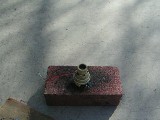 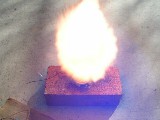 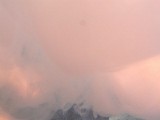  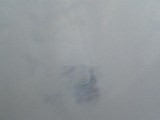 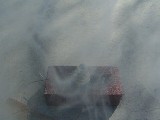 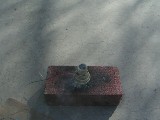
Thickness and permeability
The
material (Nomex, Kevlar or other material) is not the only consideration.
The thickness and the permeability are also factors. The weight of the
material is a direct indication of the thickness. 4 oz per square yard
is fairly light, 7 or 8 oz per square yard is fairly heavy. The
tightness of the weave can also slightly affect the thickness for a given
weight, the tighter weave being slightly thinner for the same weight. You want low
permeability in a chute protector also. Low permeability means that
not much gas will pass through it. You can do a subjective test on a
fabric by putting it up against your mouth and blowing through it. If
you can blow through it easily, it has a high permeability and is not a good
protection material. If you can't blow much air through it, it has a
low permeability and is more suitable for a protector. Burning
particles cause the most damage but the hot ejection gases and flame can also damage a
chute so you don't want those hot gases passing through the protector and
coming in contact with the parachute.
If Kevlar
isn't any better than Nomex, then when should you use it?
The main
difference between Nomex and Kevlar is that Kevlar is MUCH stronger than
Nomex and is difficult to cut. Just ask someone that has used Kevlar
instead of fiberglass over a body tube. That is why Kevlar is used in
"bullet proof vests" (puncture resistant vests) and other high strength
applications like your shock cords or recovery harness. When it comes
to strength, there is another factor that is important -- whether the fabric
is made from continuous filament or spun. Spun thread is made from
short pieces, 1/2" to 8" is normal, that are twisted together or
are wound around a small continuous filament. This is also
referred to as staple fibers and the fabric woven from it is called staple
fabric (duh!). Here is an example of the difference in strength:
Strength for size *E threads
| |
Kevlar, Filament |
25 lbs |
| |
Kevlar, Spun |
12 lbs |
| |
Nylon, Filament |
11 lbs |
| |
Polyester, Filament |
11 lbs |
| |
Nomex, Filament |
7.5 lbs |
| |
Polypropylene, Filament |
6.4 lbs |
| |
Acrylic, Filament |
5.3 lbs |
| |
Nomex, Spun |
4.5 lbs |
| |
Polyester, Spun |
2.9 lbs |
| |
Cotton, Spun |
2.9 lbs |
* There are three different common thread
sizes used in the textile industry. How these relate are shown in the
table below. Standard multipurpose polyester sewing thread is about a
Tex size 40. Lightweight is considered 23 to 69. 69 is the
heaviest you can use on a standard home sewing machine. Heavier than
that requires a commercial sewing machine.
| |
|
Tex
Size |
24 |
35 |
50 |
70 |
90 |
105 |
|
Commercial Size |
33 |
46 |
46 |
69 |
92 |
92 |
|
Government Size |
A |
B |
B |
E |
F |
F |
|
Spun fabric is much cheaper than filament woven fabric but it
is also possible to get a tighter weave and so lower permeability with
filament fabric. Nevertheless, a tight weave spun thread fabric is
adequate for chute protection, especially when used with cellulose wadding.
Use Wadding WITH
Protective Chute Material
Mark
Canepa in his book, Modern High-Power Rocketry 2, page 186 and 187,
talks about Nomex cloth and "cellulose-type" material (it is actually
treated cellulose, not "cellulose type" material) as being used separately
and then says that the "cellulose-type material" is "particularly beneficial
when used in conjunction with a Nomex pad." Actually it makes no sense to NOT use them together
unless you use an entirely different method of protection. If
you don't, you will have to replace the Nomex frequently if not after every
flight. Nomex is not that inexpensive. The
cellulose is similar to or the same thing as the cellulose insulation that
is blown into attics.
| |
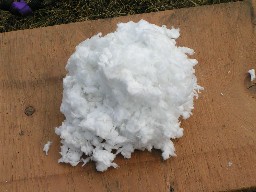
Cellulose insulation before being ejected |
|
| |
|
| |
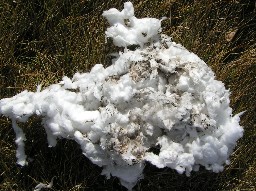
Cellulose insulation after being ejected. Note
the scorching.
|
The
wadding is put in as a sacrificial flame retardant material between the ejection charge and the
parachute and parachute protection. Cellulose insulation is treated
with a flame retardant chemical so that it will not support a flame in your
attic and you
need the same as recovery wadding in your rocket so it doesn't come down
flaming and setting something on fire. Notice I said "sacrificial"
material. It is going to be charred by the ejection charge but the
amount you would use in each flight is dirt cheap so you don't care.
It also is not going to be recovered. It will fall to earth and
decompose quickly.
So why do
you need additional chute protection if you use wadding? If you are
talking about a model rocket with a C motor in a 1" body tube, you don't.
If you are talking about a high power rocket, you do. The higher mass
of the recovery equipment will not "get out of the way" of the ejection
gases fast enough. Some will leak around the perimeter of the wadding
and can still damage your parachute. Your parachute needs to be
completely wrapped in the protective fabric, or at least bottom and sides,
so gases escaping along the inside body tube wall do not come into contact
with the parachute, and preferably, not the recovery harness (shock cord).
Nomex is
expensive, wadding is inexpensive. Since it is very cheap leave the
insulation that is in your attic there and buy some for your rocket
launches. You can usually get it at any home supply store, insulation
company, or lumber yard. It is basically just shredded paper, usually
recycled newspapers or newsprint, that has been treated with a fire retardant chemical so that it
will not support a flame. Note that it is of concern to fire
departments and agencies concerned with fire. This stuff can still
smolder and it has been argued that in a fire, it could still reignite other
flammable material after a house or building fire has been put out. In
our case, it will usually just scorch in spots, not smolder. However,
I would think about this if you are foolish enough to be launching in an
extremely high fire danger area and time period.
Rock wool
(or Rockwool) is another wadding material that can be used and is actually,
in my opinion, the best wadding material if you can find it locally.
It is used in the same way as fiberglass insulation with a paper or foil
backing and looks very similar to fiberglass insulation except it is dark
colored. It is also used as a blown in insulation but more expensive
than cellulose so not as common today. It is
made from Basalt rock and Chalk. These are melted at 1600°
C into a lava which is blown into a large spinning chamber, which pulls the
lava into fibers like "cotton candy." This material absolutely does
not burn or support a flame but can melt and discolor in spots. This
material is the favorite medium for hydroponic greenhouses and hobby
growers. It can be obtained from hydroponic suppliers but is
definitely more expensive from them than alternatives.
Testing Results
A torch
or hot air gun directed at fabric for a couple seconds is not a good test.
A proper test is actually ejecting a sample in a real situation with a
parachute or mockup and a standard ejection charge in a real rocket or mock
up body tube. See below. Also when reading about a test that is
done, note whether the material is the same weight because unless they are
the same weight and same permeability, the test is not valid.
These pictures show five out of several types
of material in their original state before being tested. The Top
Flight material had the highest permeability (lets gases through), the green
surplus was the next highest. The other three had very low
permeability.
| |
 |
 |
 |
 |
 |
|
|
|
Filament woven tight weave HT483-54 Nomex, 6.0 oz/sq yd. |
Nomex from a military contract for flight clothes,
military green, 4.5 oz/sq yd. |
Top Flight Recovery, LLC Firewall Parachute Protector,
4.0 oz/sq yd. |
Filament woven tight weave 16082 Polyester, 3.6 oz/sq yd. |
Filament woven tight weave
HT10-41 Nomex, 6.5 oz/sq yd. |
|
|
The following show the same materials as
above after being ejected from an actual 4" diameter rocket, the first
four without recovery wadding, the last (the HT10-41 Nomex) was ejected
WITH wadding. The first row of pictues show the ejection side, the
second row show the parachute side. You need to click on each
picture to view the large picture version to see clearly what the damage
is to each. Note: the colors look different because the pictures
were taken under different light conditions. |
|
 |
 |
 |
 |
 |
|
| |
|
 |
 |
 |
 |
 |
|
Note: The purpose
of these pictures is NOT to show relative damage or what type was damaged
the most. The point is that ALL fabrics ARE damaged without wadding
and every single one tested ended up with one or more actual holes in the
fabric, though small. You can see the holes better in the larger
views. It is interesting that the green light weight Nomex and the
polyester actually appear to have the least damage on the chute side.
However, keep in mind that each of these was tested only once and another
round of tests might have shown differences so again, the point is that
using any fabric chute protection without wadding is not a good idea.
Actually, I think this particular tight weave
polyester is even a better choice than a high permeability Nomex when using
wadding. The problem is that people get an idea in their
head based on what SEEMS logical and then it is hard to look at actual test
results and reality and change that opinion.
Check out the last
column, the HT10-41 Nomex. It was ejected WITH cellulose wadding and
as can be clearly seen, there is a huge difference. There is virtually
no scorching on the bottom. The only scorching is in the area that was
adjacent to the body tube and that is minimal. The hot gases were
effectively blocked from the bottom but some escape along the sides of the
tube and that portion of the protective cloth. What little scorching is
present is there. On the chute side, there is ZERO scorching.
The chute was totally protected when protective fabric AND wadding is used
correctly.
Home ||
High Power Rocketry ||
Experimental Rocketry
|
|
